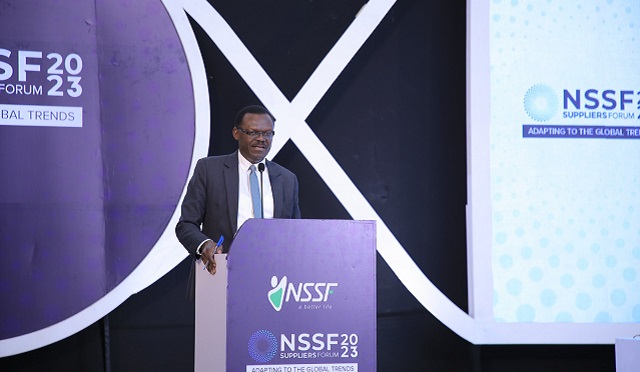
The Fund has unveiled business opportunities for FY2023/2024
Kampala, Uganda | JULIUS BUSINGE | Uganda’s National Social Security Fund has unveiled business opportunities for local firms during the Financial Year 2023/24 which starts next month.
These include investments in real estate, insurance services, advertising and promotions, information technology systems, consultancies, and office equipment.
However, the fund’s executives said competing firms will have to meet the set terms and conditions by adapting to global trends in order to earn long-term business partnerships.
Speaking at the 7th annual NSSF Suppliers Forum held in Kampala on June 20, Gerald Mugabi, the NSSF head of procurement said, these global trends include digital transformation and artificial intelligence, risk mitigation, and supply chain resilience as well as sustainability trends.
Mugabi told the forum attendees that the businesses that adapt to these trends would increase their competitiveness and growth in the long run.
NSSF Acting Managing Director, Patrick Ayota said the Fund, like any other business, has reached a point where it needs to re-invent itself to guarantee its sustainability in line with global trends.
“We are cognizant of the new realities around the Fund that include more demands on cashflows through benefits payments. Therefore, our focus in the next fifteen years will be on expansion of social security coverage, growth, and shared value to enable us to sustain our business,” Ayota said.
He challenged local firms to come up with solutions that will support the Fund in its new strategic direction.
He advised firms to invest in artificial intelligence, machine learning, the Internet of Things, and data analytics to gain business competitiveness. The other areas of focus are investing in initiatives that reduce carbon footprint, and the usage of plastics.
“The preferred NSSF supplier will be one who has established or put in place environmental protection initiatives,” he said.
Ayota urged the participants to start planning to mitigate supply chain risks to withstand disruptions from geopolitical shifts, pandemics, and economic shocks.
More focus, Ayota said should be put toward information sharing and joint problem-solving to ensure resilience and meet customer demands, plus harnessing training programs and continuous learning to build a future-ready workforce.
Setting the pace
Ayota said, the Fund is already organized and moving according to the changing times, which is why their suppliers should follow suit. For instance, the Fund’s operational processes are 95% digitized; it has deployed robotic process automation to facilitate electronic payment to suppliers.
The other areas the Fund has invested in include; the Hi innovator projects with Shs11bn put aside to support talented Ugandans in business; self-service portals like automated contribution collection, online member portal, and integration with banks and payment platforms; e-requestioning and e-sourcing for providers.
The Fund has in the process increased convenience in service delivery, enhanced quick decision-making and visibility across the supply chain, created more flexibility in the work environment, and ensured the accuracy of inventory management and forecasting demand.
Currently, NSSF is a multi-trillion organization mandated by the government through the NSSF Act, as amended, to provide social security services to employees in the private sector.
Strategic investments in its operational processes have made it become a safe, innovative, and dynamic social security provider that guarantees safety, security and a competitive return on members’ savings of over 2% above the 10-year inflation average.
The Fund is currently East Africa’s largest by asset managing assets in excess of Shs17.8 trillion, invested in fixed income, equities, and real estate assets within the East Africa region.
Going forward, Ayota said, convenient collaboration with suppliers will easily make the Fund achieve its ambitious goal of growing its Assets Under Management to Shs20 trillion by 2025.
 The Independent Uganda: You get the Truth we Pay the Price
The Independent Uganda: You get the Truth we Pay the Price



